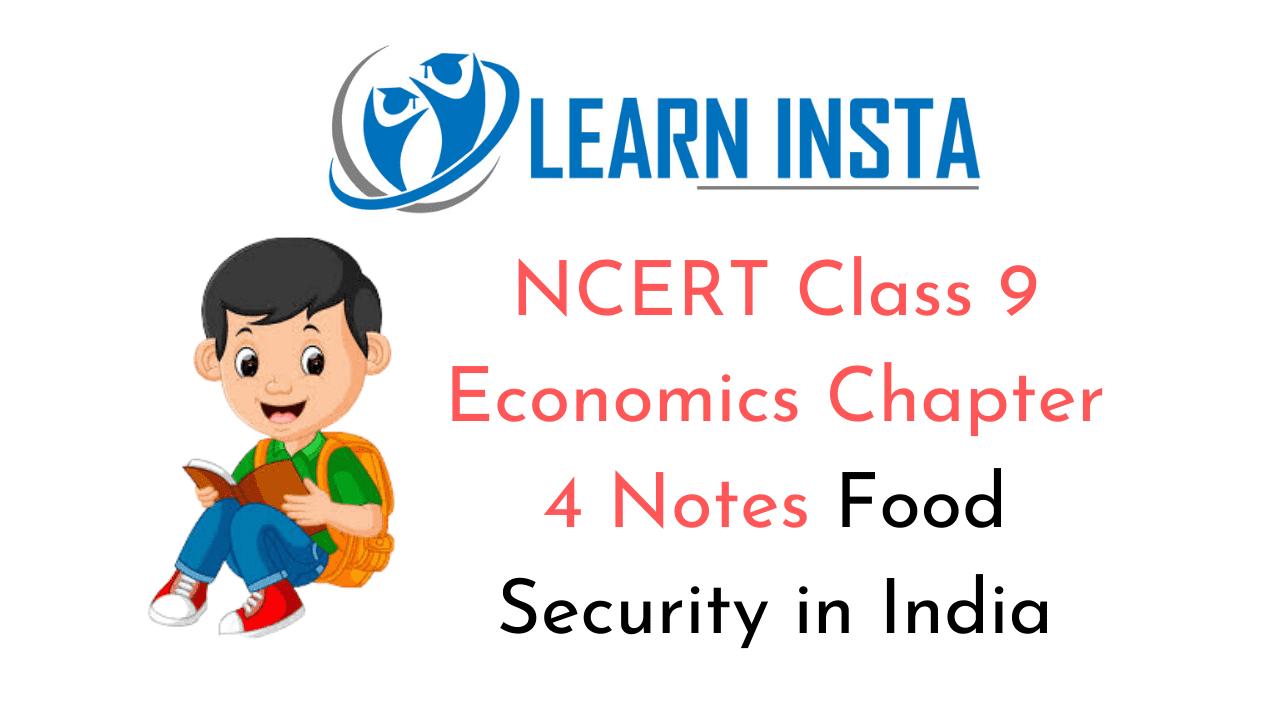
On this page, you will find NCERT Class 9 Economics Chapter 4 Notes Pdf free download. CBSE Class 9 Social Science Notes Economics Chapter 4 SST Food Security in India will seemingly, help them to revise the important concepts in less time.
Food Security in India Class 9 Notes Social Science Economics Chapter 4
CBSE Class 9 Economics Chapter 4 Notes Understanding the Lesson
1. Food is essential for living. Food security means something more than getting two square meals. Food security is ensured in a country only if all of its citizens have enough nutritious food available, all persons have the capacity to buy food of acceptable quality and there is no barrier on access to food.
2. The people living below the poverty line might be food insecure most of the time while better off people might also be food insecure at the time of a national disaster or calamity like earthquake, drought, flood, etc.
3. Due to a natural calamity, total production of food grains decreases which creates shortage of food. Due to shortage of food, the prices goes up. In such a situation poor people fail to buy food. If this condition remains for a longer time, it may cause a situation of starvation. A massive starvation might take a turn of famine.
4. Although a large section of people suffer from food and nutrition insecurity in India, the worst affected groups are landless people with little or no land in rural areas and people employed in ill- paid occupations and casual labourers engaged in seasonal activities in the urban areas.
5. The social composition along with the inability to buy food also plays a role in food insecurity. The SCs, STs and some sections of the OBCs are prone to food insecurity. A great number of women are also food insecure.
6. The food insecure people are disproportionately large in some regions of the country, such as economically backward states with high incidence of poverty, tribal and remote areas, regions prone to natural disasters, etc.
7. Hunger is another aspect indicating food insecurity. The attainment of food security therefore involves eliminating current hunger and reducing the risks of future hunger.
8. Hunger may be chronic or seasonal. Chronic hunger is a consequence of diets persistently inadequate in terms of quantity and /or quality. Seasonal hunger is related to cycles of food growing and harvesting.
9. India is aiming at self-sufficiency in food grains since Independence. The Green Revolution which took place in agriculture resulted in the increased production of food grains especially wheat and rice.
10. The increase in food grains was, however, disproportionate. It was highest in Uttar Pradesh and Punjab. But production of food grains has dropped in states like Uttarakhand, Jharkhand, Assam, etc.
11. Since the advent of the Green Revolution in the early 70s, famine-like situation has never occurred even during adverse weather conditions. India has become self-sufficient in food grains during the last thirty years because of a variety of crops grown all over the country.
12. To ensure availability of food to all sections of the society the Indian government carefully designed food security system which is composed of two components: (a) buffer stock and (b) Public Distribution System.
13. Buffer stock is the stock of food grains, namely wheat and rice procured by the government through Food Corporation of India (FCI). The FCI purchases wheat and rice from the farmers at a pre-announced price and store them in granaries. This is done to distribute food grains in the deficit areas and among the poorer section of society at a price lower than the market price.
14. The food procured by the FCI is distributed through government-regulated ration shops called the Public Distribution System (PDS). Ration shops are now present in most localities, villages, towns and cities,
15. In addition to PDS, various poverty alleviation programmes were also started which comprised a component of food security. Some of these programs are-Integrated Child Development Services (ICDS); Food-For-Work (FFW); Mid-Day-Meals, Antyodaya Anna Yojana (AAY), etc.
16. In addition to the role of the government in ensuring food security, there are various cooperatives and NGOs also working intensively towards this direction.
17. The cooperative societies set up shops to sell low priced goods to poor people. For example, Mother Dairy in Delhi. AMUL is another success story of cooperatives in milk and milk products from Gujarat.
18. In Maharashtra, the Academy of Development Science (ADS) has facilitated a network of NGOs for setting up grain banks in different regions.
Food Security in India Class 9 CBSE Notes Important Terms
Food security: It means availability, accessibility and affordability of food to all people at all times.
Famine: Extreme scarcity of food.
Starvation: Suffering or death caused by lack of food.
Malnutrition: Lack of proper nutrition, caused by not having enough to eat, not eating enough of the right things, or being unable to use the food that one does eat.
Hunger: A feeling of discomfort or weakness caused by lack of food, compelled with the desire to eat.
Buffer stock: The stock of food grains.
Granary: A storehouse for threshed grain.